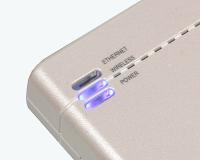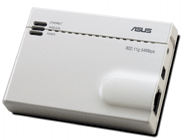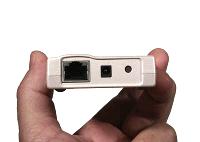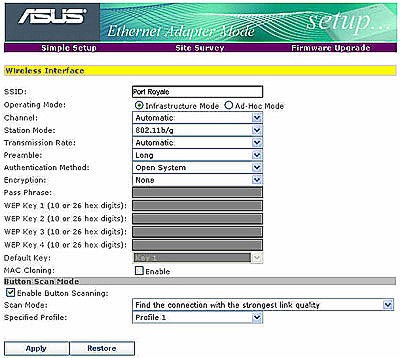
VOICE Home Page: http://www.os2voice.org
Newsletter Index
< Previous Page | Next Page >
Feature Index

VOICE Home Page: http://www.os2voice.org |
March 2005
Newsletter Index
|
| By Daniela Engert © March 2005, Translation: Jürgen Gaida |
It was in October 2004 when the dilemma began: I had a brand new notebook with a 54 MBit WLAN (Intel Centrino 220bg), was attending Warpstock Europe in Arnhem--and the OS/2 driver was not yet ready for real employment! Willibald Meyer had built an extension in his GenMac driver which allows Windows XP drivers to run in OS/2 (the so-called NDIS wrapper function); this should have enabled WLAN with my new notebook. Although his tests with the Intel 2100 chip were successful, the Intel 2200 driver was not stable in OS/2. Therefore another solution was required. Since I did not want to carry a 10m TP patch cable around, Willis suggested an alternate proposal which sounded more interesting: a small [Wireless] Access Point from Asus which could operate as a WLAN client as well.
As I had no access point at home so far, I very much appreciated the idea of having a device with dual functions as an access point and WLAN client. Checking the Asus website showed there was already a successor with 54 MBit/s available, the Asus WL330g Pocket Wireless Access Point. Various test reports found on the Internet painted a positive picture of the device. As time was getting short, I invested the 50€ and ordered one unit. It was delivered promptly within 2 days.
 The case, closed with a zipper, contains the access point which is similar in size to a cigarette box
(86 mm x 62 mm x 17 mm).
Also included are an Ethernet patch cable of about 30cm, a
USB cable of the same length for power supply, and
a "wall wart" [AC adapter] as an alternate power solution.
The case, closed with a zipper, contains the access point which is similar in size to a cigarette box
(86 mm x 62 mm x 17 mm).
Also included are an Ethernet patch cable of about 30cm, a
USB cable of the same length for power supply, and
a "wall wart" [AC adapter] as an alternate power solution.
To operate as a client it is sufficient to connect the WL330g to the
LAN port of a PC or notebook
and to a USB port for power. Using the WL330g as access point--at home or in a hotel--connect
to the LAN port and preferably supply power with the wall wart. Both antennas are completely contained within the case.
 Three LEDs indicate the state: Link via the Ethernet port,
WLAN activity, and Power. When transferring data, the
WLAN LED blinks. On the rear side is a switch to choose between the 2 modes: access point and WLAN client.
Toggling causes a reset of the WL330g.
Three LEDs indicate the state: Link via the Ethernet port,
WLAN activity, and Power. When transferring data, the
WLAN LED blinks. On the rear side is a switch to choose between the 2 modes: access point and WLAN client.
Toggling causes a reset of the WL330g.
The following pictures show the appearance and the interfaces of the WL330g.

 The LAN port is on the left, the power connector in the middle (used by the USB cable or wall wart), and on the
right side there is the pushbutton which toggles to the next available wireless network when running in client mode.
The LAN port is on the left, the power connector in the middle (used by the USB cable or wall wart), and on the
right side there is the pushbutton which toggles to the next available wireless network when running in client mode.
The following list gives a comprehensive overview of the capabilities of the WL330g:
Especially the WPA function of this device is of interest for users who already have working WLAN hardware with OS/2 support. As far as I know, a software implementation of the WPA protocol does not exist for OS/2. Certainly it is possible to implement a so-called "WPA-Supplicant" which would supply the WPA protocol and the necessary automated key changes. But this means that someone needs to port to OS/2 one of the freely available supplicants. Until then devices like the WL330g are mandatory to access WLANs which are secured by WPA.
 Configuration of the WL330g is done in two ways. For Windows systems a configuration program is available. Alternatively
all settings are accessible with a web browser as the Pocket Access Point has a built-in web server.
Configuration of the WL330g is done in two ways. For Windows systems a configuration program is available. Alternatively
all settings are accessible with a web browser as the Pocket Access Point has a built-in web server.
The default IP address for configuration page is set to 192.168.1.1. As many DSL routers use the same address, problems may occur. Hence the WL330g can be assigned an IP address via DHCP, or may be configured to a different static address. To use the device in client mode--where no DHCP server is available!--I preferred to set up my WL330g with a static, non-conflicting address from the private IP address range 172.16.0.0/20 (e.g.: 172.19.20.21); any similar address range would be suitable. The PC or Laptop that accesses the configuration web server must have an address in the same address range, of course (e.g.: 172.19.20.1). This IP address can be joined with an IP Alias to the same LAN port in addition to the regular IP address used for the normal network traffic (e.g.: 192.168.1.x, assigned by DHCP). To provide this I modified the OS/2 TCP/IP setup batch file \MPTN\BIN\SETUP.CMD as follows:
---- SETUP.CMD -------- route -fh arp -f ifconfig lo 127.0.0.1 dhcpstrt -i lan0 <---- regular IP Address for lan0 by DHCP ifconfig lan0 172.19.20.1 netmask 255.255.255.0 alias <---- static Alias IP Address for lan0 ---- SETUP.CMD --------
It should be possible to set up the IP Alias using the OS/2 TCP/IP configuration object, but I did not check. If everything goes ok, the following TCP/IP routes are present:
[d:\]netstat -r
destination router netmask metric flags intrf
default 192.168.1.1 0.0.0.0 0 UGP lan0
127.0.0.1 127.0.0.1 255.255.255.255 0 UH lo
172.19.20 172.19.20.1 255.255.255.0 0 UC lan0
192.168.1 192.168.1.11 255.255.255.0 0 UC lan0
It is easy to see that the two IP addresses are linked at LAN port lan0: 192.168.1.11 (assigned by DHCP from the DSL router) and 172.19.20.1. I modified \MPTN\ETC\HOSTS so I can use the Asus Pocket Access Point with a name rather than a combination of numbers:
---- HOSTS ------- 127.0.0.1 localhost localhost 192.168.1.1 router router 172.19.20.21 pocket-ap pocket-ap ---- HOSTS -------
Having made these changes the configuration pages of the WL330g are accessed from any javascript-capable Browser with the URL http://pocket-ap. Well, before firmware version 1.12 it is not that simple: web pages are displayed correctly only in access point mode. In client mode the transmission of the HTML code is aborted before completion. It looks like the embedded web server in the WL330g is corrupt; MAC OS is affected by this problem as well. Since firmware version 1.12, the web pages work in client mode as well. If by bad luck someone gets a unit with the old firmware, download an update from the Asus web site (ZIP Archive, so no problem) and transfer it in AP mode via the firmware update/configuration page on the WL330g.
The pictures below show the main configuration page, the first in access point mode and the second in client mode.

Setup Page in Access Point Mode

Setup Page in Client Mode
Additional pages exist for the MAC Access Filter, firmware upgrades, the list of associated WLAN clients and a list of the available wireless networks. From my view the number of settings is both extensive and complete. Although I am an amateur in wireless networking, the settings presentation appears logical and obvious; I could deal with it at first go.
The Asus Pocket Access Point fulfilled my expectations with its first practical usage at Warpstock Europe in Arnhem. By means of it I could access the provided WLAN in client mode. And now the WL330g works as access point in my home LAN, too. Since the GenMac driver from Willibald is now working with the Intel 2200 Windows XP driver, I can use my notebook with WLAN as well. :-)
My final judgement: Recommended!
References:
|
Feature Index
editor@os2voice.org
< Previous Page | Newsletter Index | Next Page >
VOICE Home Page: http://www.os2voice.org